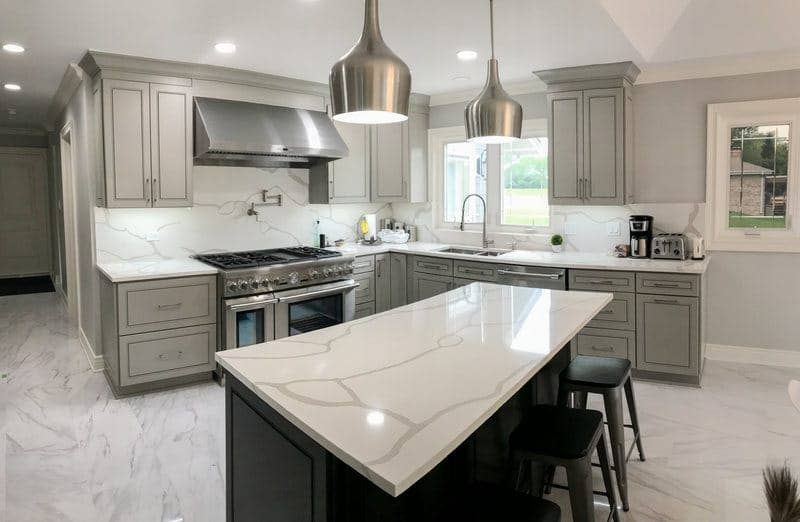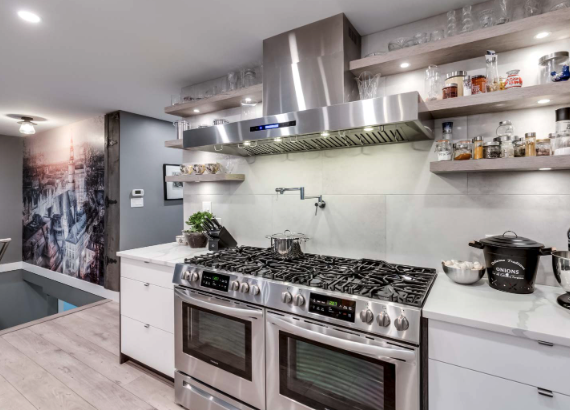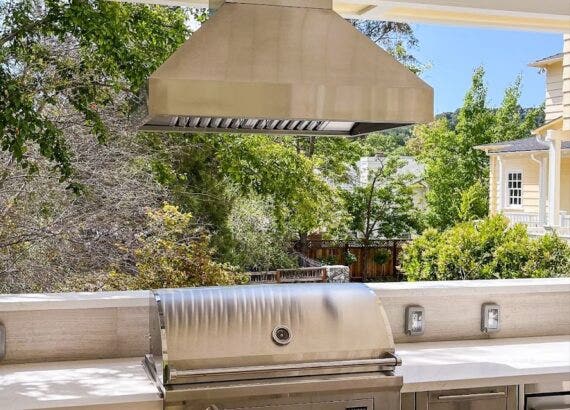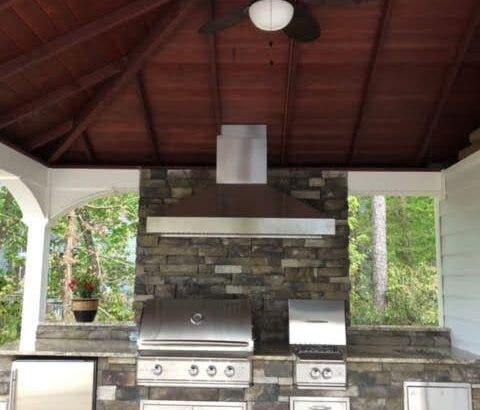Can a range hood be vented into the garage?

Ducted range hoods are the most popular hood for your home. But buying a ducted hood requires a little research so you can complete the installation successfully.
We’re here to help you jumpstart that research. One common question our customers ask is, Can a range hood be vented into the garage?
No, a range hood cannot be vented into the garage. Cooking exhaust and harmful gases produced from your stove will build up inside which is dangerous for your health. As heavy grease and oil accumulate, your garage will become a fire hazard. Your garage will be difficult to clean and the hot greasy air may damage your upholstery.
You can vent a range hood through the garage to the outside, as long as the outlet is at your roof or an outside wall. But aesthetically speaking, you might want to avoid having exposed ductwork in your garage.
4 Reasons You Can’t Vent Your Kitchen Exhaust Hood Into the Garage
Grease gets everywhere.
In your garage, you probably have a lot of things you don’t mind getting a little dirty. Tools, paint cans, wood, sheet metal…the list goes on.
But do you really want a layer of grease and grime on everything in your garage, including your cars? You’ll have your range hood for years, even decades. Think about all the cleaning you’ll have to do if you vent your hood into the garage. It won’t be pleasant!
If you like parking your car in the garage now, you’ll find out quickly that’s not a good idea if you vent into the garage. Vent your hood to the outside instead.
Grease, oil, and contaminants produced from your stove are dangerous for your health.
The purpose of a range hood is to vent the cooking exhaust and contaminants produced from your cooking to the outside of your home. But if you vent into the garage, that defeats the purpose of your hood. The contaminants and grease will simply accumulate in your garage.
Instead of removing the contaminants from your home, you’ve just moved them to a smaller area. Your garage is more than likely a place you’ll frequent too. Probably multiple times a day! You don’t want to breathe in that greasy, dirty air for days on end.
The build-up of grease and chemicals is the most pressing concern. Garages are typically not well ventilated. So the contaminants will keep accumulating, day after day, week after week.
Keeping your garage open isn’t a permanent solution, either. It can keep a lot of the harmful contaminants out. But you’ll still have the problems of heavy grease buildup and a potential fire hazard.
Also, the point of a garage door is that you can close it. What will you do in the winter when it gets quite cold? You’ll probably want to close your garage door then. Even if you’re in a warmer climate and you can keep your garage door open, you’re better off venting directly to the outside.
Grease buildup may turn your garage into a fire hazard.
Chances are your garage is already holding some flammable liquids like paint or gasoline. Add onto that oily, greasy air that can build up quicker than you might think. Yup, your garage can be a pretty dangerous place.
A spark or flame could result in a fire. So, be cautious if you want to use any power tools in your garage. Do you like to sharpen your kitchen knives with a knife sharpener? You’ll want to do that outside.
Moisture buildup can lead to mold growth or other damage to your garage.
Along with the buildup of grease and oils, a lot of moisture can accumulate in your garage. After a few weeks, this can lead to mold damage.
6 Range Hood Venting Best Practices
Use as few elbows as possible.
To ensure all the greasy air makes it to the outside, use as few elbows as possible in your ductwork. Each elbow adds quite a bit of resistance. Too many elbows can lead to heavy grease buildup in the duct system.
The duct should run upward or level, since hot air rises.
Hot air rises, so if possible, run your duct upward or straight. Otherwise, grease may stick to the edges of the duct, causing problems in the long run.
Eventually, so much grease will accumulate that the air won’t be able to make it to the outside. You may start noticing that your kitchen stays smoky even with your range hood on.
Use the shortest duct run possible to the outside.
The shorter the duct run, the easier it is for all the greasy air to escape to the outside. Make sure your duct is under 30’ for the best results. Otherwise, your range hood won’t run as efficiently as it should.
Even if it’s the shortest path to the outside, do not vent your hood into the garage or attic.
Cap your duct with a wall or roof cap.
The best practice is to cap your duct with a wall or roof cap. This prevents debris or small animals from climbing inside. It also prevents backdrafting, which occurs when outside air travels inside your range hood duct.
Vent through the ceiling or through an interior wall.
Instead of venting into the garage, vent through your ceiling or an interior wall. It’s much safer and the healthiest option for you and your family – as long as you follow the ducting best practices.
Use rigid metal ductwork.
For the most efficient duct system, use rigid ductwork to vent your range hood. Flexible duct is quite cheap and won’t last nearly as long as a rigid duct.
Hopefully we answered your question, Can my range hood be vented into the garage? Remember, avoid this at all costs!
Learn more about range hood installation at the links below.
Related Articles
How to Find a Contractor to Install a Range Hood (Ultimate Guide)







Comments are closed.